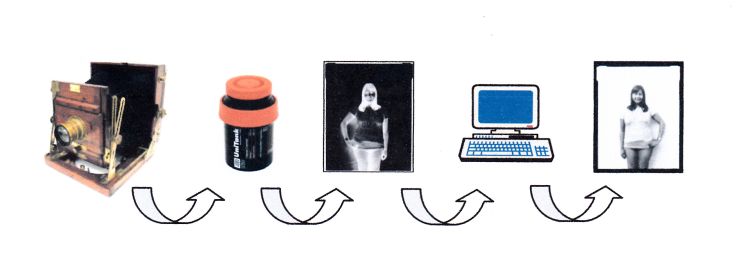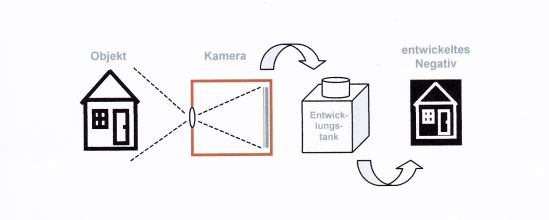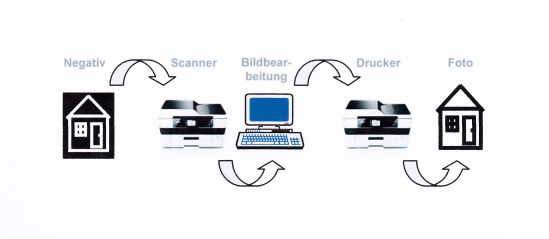The Calotype of the 21st Century
A Hybrid Process analogue – digital

Fig. 1
A distinct development to integrate the Calotype in the digital photography is the Hybrid process. With this modern technique the darkroom laboratory will be obsolete (Fig.1).
What is a Calotype? This is the first negative-positive process of the world. So it has been named colloqually since the 1850-s years. It works like this: with a photographic paper a negative is produced and by this, and normally by a contact copy a positive, the photo, will be created in the darkroom.
Is it legitimate to call the produce a calotype even if the second part of the process – the darkroom – is taken over by digital technique?
If we take a closer look at what took place in the early 19th century, then we take a conclusion as follows:
- The creator of the Calotype was W.H.F. Talbot. He presented his invention at the Royal Society in London in 1839 and he called it Photogenic Drawing. With his presentation he described the negative-positive process in general.
- In 1841 Talbot gained the patent #8842. In this he defines for the first time what a calotype is, but the naming calotype refers only to the negative. He mentions that the negative should be highly sensible to visible light. The more the user is free to select the material to create the copy, that is the positive, the foto.
I interpret that W.H.F. Talbot defined a general negative-positive photographic process and he names the paper negative Calotype. The process to create the copy is not defined by him. So the copy can be created by any technique. Why not digital?
Here I present my suggestion for a calotype (in a general sense) for the 21st century:
- Step 1: make an analogue negative,
- Step 2: scan the negative and make a digital print.
My Thesis: Talbot would had been delighted by the digitalisation of his process.
Daguerrotypes were unique copies, he wanted the unlimited dublication of the photo, as with the digital photography.
W.H.F. Talbot had developed the conceptual basis for modern photography. He was far ahead of his time.
Fundamental properties of a photo due to contact or digital copying
A calotype negative is always a photographic paper. So it is very different to a negative on a transparent layer. The reason for this is the high density and structure of the paper.
When paper negatives are projected with an enlarger the contrast and the focus get lost. The reason for this is the extreme dispersion of the opaque layer. Therefore sharp pictures can only obtained by contact copy or digital, the latter allows enlargement by reduced quality losses.
Here is an example of a scanned negative (Fig.2+3, ...6x6 cm negative), format 6x6 cm, converted to positives by software (Fig. 4+5). The digitalization took place first with a reflective scanner and then with a transparency scanner. Let us have a look at these different photos. The transparency scanner produces soft and not perfectly sharp images, but a somewhat strange sky related to the paper structure. This effect is well visible in the following prints of „Burg Plesse“ and „La Mezquita“. This is the consequence of the very thick layer (Resin paper).
The reflective scanner produces a sharper picture but a homogeneous sky. The result is an orthochromatique print, representing only the blue part of the light if the negative was a fixed graded negative material.
In both cases the grey scale is non-realistic: red appears too dark, blue too bright, like it is with the old black and white movies of the 1920s or 1930s. So the calotypes get their antique impression. So even with low price scanners (combined scanner) or combined printer-scanners very interesting results are possible. For the transparency scanner we recommend a scanner for diapositives for medium or large format.
Please consider: scanned negatives are mirror inverted and should be changed by software.
Analogue processed Calotyps
Here are two examples of strictly analoque produced prints. (Fig. 6 & 7). The negatives are of 4x5 inch. The extreme density of the layer produces an gradation by extremes like it is visible with the castle Plesse (Abb. 6). So a photo only shows between 5 and 6 different grey tones even if this is not visible at first glance. This is clear abstraction and far off from reality. This offers a creative tool to interpret an object by the means of exposure.
The photo of the church San Miguel Bajo in Granada (Fig. 7) shows a sky with a strange structure based on the erratic paper structure of the negative. This occurs mainly in the sky or other homogenous surfaces. This appearence can be achieved only by a complete analogue process or by a transparency scanner.
So, the integration of the calotype process into the digital world of the 21st century is firstly the separation into the analoque development of the negative and secondly its digitalization and further processing by computer technique.
The Hybrid-Process: the Calotype of the 21st Century
Here I like to suggest a Process for a Calotype of the 21st century. An exposed negative is to be developed in a developing tank and afterwards being scanned. I like to point out again that only with a transparency scanner or film scanner the full effect of the Calotype is achieved.
Analogue Process step to produce a Negative

Fig. 8
The negative will be developed in a tank. The tank can be loaded with the negatives with a changing bag. So a darkroom will be not necessary. Afterwards the chemicals can be filled in and the negatives will be developed.
Digital Process step to make the Copy

Fig. 9
In the second step the nagative will be scanned, modified by software and printed as a positive. So my Hybrid-Calotype-Process allows to produce a photo with all the characteristics of the classical Calotype but with the modern options only the digital world can offer.
Good, ol´ Calotype: welcome to the present time of the digital world. H.W.F. Talbot was a genious mentor. His basic concept to make by a template – negative or file – unlimited amounts of copies will last for ever in photography.
 Fig. 1
Fig. 1  Fig. 8
Fig. 8 Fig. 9
Fig. 9